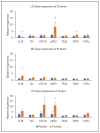Safety Evaluation of an Intranasally Applied Cocktail of Lactococcus lactis Strains in Pigs
- PMID: 38003060
- PMCID: PMC10668741
- DOI: 10.3390/ani13223442
Safety Evaluation of an Intranasally Applied Cocktail of Lactococcus lactis Strains in Pigs
Abstract
Three Lactococcus lactis strains from the nasal microbiota of healthy pigs were identified as candidates for reducing MRSA in pigs. The safety of nasal administration of a cocktail of these strains was examined in new-born piglets. Six days pre-farrowing, twelve sows were assigned to the placebo or cocktail group (n = 6/group). After farrowing, piglets were administered with either 0.5 mL of the placebo or the cocktail to each nostril. Health status and body weight were monitored at regular time points. Two piglets from three sows/treatment group were euthanised at 24 h, 96 h and 14 d after birth, and conchae, lung and tonsil samples were collected for histopathological and gene expression analysis. Health scores were improved in the cocktail group between d1-5. Body weight and daily gains did not differ between groups. Both groups displayed histological indications of euthanasia and inflammation in the lungs, signifying the findings were not treatment related. The expression of pBD2, TLR9 and IL-1β in the nasal conchae differed between groups, indicating the cocktail has the potential to modulate immune responses. In summary, the L. lactis cocktail was well tolerated by piglets and there was no negative impact on health scores, growth or lung histopathology indicating that it is safe for administration to new-born piglets.
Keywords: LA-MRSA; bacterial cocktail; gene expression; growth; histopathology; pigs; safety.
Conflict of interest statement
The authors declare no conflict of interest. The funders had no role in the design of this study; in the collection, analyses or interpretation of data; in the writing of the manuscript or in the decision to publish the results.
Figures


Similar articles
-
Postpartum meloxicam administration to sows but not split-suckling increases piglet growth and reduces clinical incidence of disease in suckling piglets.J Anim Sci. 2023 Jan 3;101:skad275. doi: 10.1093/jas/skad275. J Anim Sci. 2023. PMID: 37591793 Free PMC article.
-
Potential effect of two Bacillus probiotic strains on performance and fecal microbiota of breeding sows and their piglets.J Anim Sci. 2022 Jun 1;100(6):skac163. doi: 10.1093/jas/skac163. J Anim Sci. 2022. PMID: 35512239 Free PMC article.
-
Oral Meloxicam Administration in Sows at Farrowing and Its Effects on Piglet Immunity Transfer and Growth.Front Vet Sci. 2021 Feb 11;8:574250. doi: 10.3389/fvets.2021.574250. eCollection 2021. Front Vet Sci. 2021. PMID: 33681319 Free PMC article.
-
Administration of carbetocin after the first piglet was born reduced farrowing duration but compromised colostrum intake in newborn piglets.Theriogenology. 2019 Apr 1;128:23-30. doi: 10.1016/j.theriogenology.2019.01.021. Epub 2019 Jan 29. Theriogenology. 2019. PMID: 30735915
-
Detection of Bifidobacterium animalis subsp. lactis (Bb12) in the intestine after feeding of sows and their piglets.Appl Environ Microbiol. 2008 Oct;74(20):6338-47. doi: 10.1128/AEM.00309-08. Epub 2008 Aug 8. Appl Environ Microbiol. 2008. PMID: 18689506 Free PMC article.
Cited by
-
Swine farm environmental microbiome: exploring microbial ecology and functionality across farms with high and low sanitary status.Front Vet Sci. 2024 Jul 3;11:1401561. doi: 10.3389/fvets.2024.1401561. eCollection 2024. Front Vet Sci. 2024. PMID: 39021414 Free PMC article.
References
Grants and funding
LinkOut - more resources
Full Text Sources

